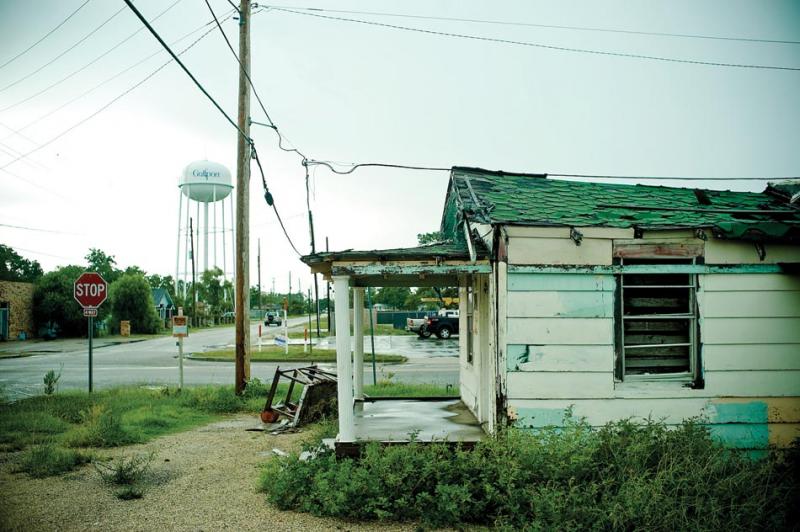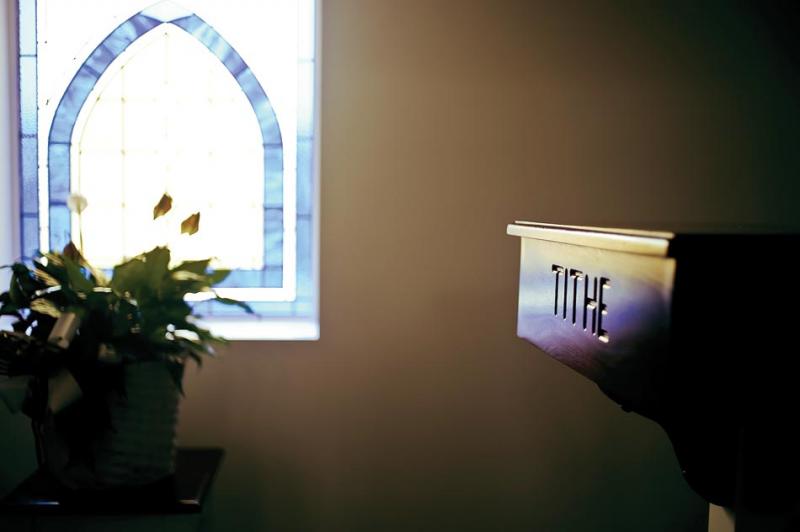Somewhere in the post-Katrina wreckage and disarray of my grandmother’s house, there is a photograph of my brother Joe and me, our arms around each other’s shoulders. We are at a long-gone nightclub in Gulfport, the Terrace Lounge, standing before the photographer’s airbrushed scrim—a border of dice and playing cards around us. Just above our heads the words HIGH ROLLERS, in cursive, embellished—if I am remembering this right—with tiny starbursts. It is 1992, the year the first casino arrived on the Mississippi Gulf Coast, and with it a new language meant to invoke images of high-stakes players in exclusive poker games, luxurious suites on the penthouse floor, valet parking, and expensive cars lined up in a glorious display of excess. Scenes from a glamorous casino someplace like Monte Carlo or Vegas—nothing like the gravel parking lot outside the club, the empty lot beyond it, and the small, run-down houses on either side, each with a chained-up dog barking into the night.
Gambling has long been a part of Mississippi Gulf Coast history. The first legalized offshore casino and resort hotel, the Isle of Caprice, opened in 1926—roughly a quarter century after the City of Gulfport received its charter. Though it would be gone within a couple of years—submerged in the Gulf—the Isle of Caprice foreshadowed the emergence of the centerpiece of the Coast’s tourism industry—gaming. At the turn of the twentieth century, the Coast had other industries too—lumber shipping and seafood—and my ancestors most likely came for the work: my great-grandmother as a domestic worker in the big houses near the beach, and my great-grandfather—because blacks weren’t employed in the seafood industry—as a longshoreman on the docks. They arrived around the same time Gulfport received its charter of incorporation, and settled just outside the city limits, in an area that came to be known as North Gulfport.
Roughly five miles from the beach and downtown, North Gulfport actually occupies a middle ground in Gulfport, and yet—until recently—the City of Gulfport’s annexation of other outlying districts diverted the lines around it, skipping over the entire area in order to incorporate the white and affluent residential districts that had developed, due north, beyond it. One of two historically African-American communities that sprang up along the Mississippi Gulf Coast after emancipation, North Gulfport has always been a place where residents have struggled with a lack of civic resources extended to other outlying communities. Isolated and unincorporated, North Gulfport lacked a basic infrastructure: flooding and contaminated drinking water were frequent problems. And although finally incorporated in 1994, many of North Gulfport’s streets still lack curbs, sidewalks, and gutters. Before the arrival of the casinos brought tourists down Highway 49 toward the beach, there were few streetlights and North Gulfport was cast in darkness. In recent years, as developers have acquired land in the community for commercial purposes—as the city has redistricted homesteads as commercial rather than residential property—many elderly citizens have lost their homes. Higher property taxes have forced people out even as property values declined. “For Sale” signs abound, and developers seeking to fill in the nearby wetlands continue to threaten the environmental safety of North Gulfport’s residents. Highway 49, rerouted and expanded after WWII, long ago cut the community in half. In a state as poor as Mississippi, residents in North Gulfport face even higher rates of poverty than the state average.
During the time that I was growing up there, North Gulfport was referred to as “Little Vietnam” because of the perception of crime and depravity within its borders—as if its denizens were simply a congregation of the downtrodden. Even now, it is a place that outsiders assume to be dangerous or insignificant—run-down and low-income, a stark contrast to the glittering landscape of the post-Katrina beachfront with its bright lights and neon bouncing off the casinos onto the water. When the producer working on this project, Lu Olkowski, talked to a reporter at a local newspaper about walking or driving through North Gulfport to meet and interview residents, he told her—assuming dangers she’d face there as a white woman—“no good could come of that.” Still, it is the place I consider my home, and the people in it, my people. For that reason, I learned that returning to document something of the struggles of a few people there, to look at the place with the detached—though empathetic—gaze of the reporter who enters a community as outsider was no easy task. Part of me was somehow still inside, no matter how long I had been away, and I could not remove myself from the story. Thus, the people whose stories I considered were literally and figuratively my own kinfolks.
Tamara Jones is my cousin by marriage. She lives across Highway 49 from my grandmother’s house in the house left to her by our great-uncle Son Dixon. She is constantly in and out of danger of losing the house after having taken out a small sub-prime mortgage to pay for some much-needed repairs. Now that her oldest son is away in the Coast Guard, she can’t work two jobs as she always did; her youngest would be home alone in the evenings—and she can’t afford childcare. Tammy is a devoted mother with a smart and disarming sense of humor—often self-referential—always loving. Most nights after she finishes work, she’s either at church or at one of her son’s middle school sports events, watching him play.
Roy Lee Jefferson is married to Tammy’s sister Chantal. He works a day job for a lawn service company, and four nights a week at a fast-food restaurant. Talking with him is an exercise in the scatological. Still, he is quick thinking and shrewd, and his mocking playfulness has an edge of wisdom to it. He stops by Tammy’s house frequently to sit on the stoop and drink a beer. He knows his pay isn’t equitable with that of others at his job, and not commensurate with his years at the company, so he keeps looking for other work and struggling to provide for his family.
My brother, Joel Grimmette, at only thirty-six, has had to rebuild his life three times after losing everything. To put his name in print, to place it in the context—publicly—of my own history, is to attach myself to the name of a murderer, to a past I thought I could put behind me. Joe was ten years old in 1985 when his father, my stepfather, murdered our mother. I was away at school. He was there to see it. And at that moment he became a statistic—one of the many African-American children living with a grandparent. Joe grew up in North Gulfport, in the household of our maternal grandmother, a loving woman who—nonetheless—saw the face of her daughter’s murderer when she looked at him. Neither my grandmother nor I thought of the burden Joe carried by looking like his father, by sharing his name.
Years later, when it seemed the worst was behind him, Joe began to take over the family business—managing the rental property my grandmother owned in the community. In the year leading up to Katrina, my brother fixed up the shotgun houses that had been for so long in various states of disrepair. Using most of his savings, he put in new floors and carpet, new countertops and appliances, new window screens and paint. In this way, he’d become part of the revitalization of the community and the efforts to maintain it as residential rather than commercial. Many of the tenants had lived in those houses for over twenty years. At only $250 a month, the rent was affordable—particularly for the low-income residents who relied on a small disability check for their income, or for the young mother making a living cleaning rooms at a motel on Highway 49. Often, on the days Joe was working outside the houses, someone would stop by to watch him work, to say thanks. When the storm hit, he lost everything—including his savings. Joe had needed to get all of the houses up to code and rented in order to make enough money to have them insured. Like many people in North Gulfport, my grandmother had never been able to afford insurance. Joe had put everything he had into what was now a series of vacant lots, and he was struggling to pay the taxes so that he wouldn’t lose the land too.
For a year or so after Katrina hit, there was at least work to be had on the coast. The government contractors were hiring crews for the work of clean up—flagging and directing traffic, distributing supplies, scanning the beach for hazardous debris. My brother did it all. Afterwards, when the contractors pulled out of Gulfport and other devastated Mississippi coastal towns, there was very little work. I can only imagine that in the midst of all that devastation and loss did my brother finally make a desperate decision: when someone he’d known a long time asked him to transport and deliver four ounces of cocaine, he did. He made $4,000. So he did it again. There was still the possibility of a life he imagined, and it must have been in sight, reflected in the images of the “good life” plastered on casino billboards up and down Interstate 10 and down Highway 49 toward the beach—attractive people, in elegant clothes, laughing into cocktail glasses poised above plates of beautiful, abundant food.
I can’t help thinking that the photograph we made in 1992 foreshadowed something else. Driving through the old neighborhood, I remembered that my brother and I had waited in a long line to have it taken. The line had stretched around the dance floor, and we stood there with everyone else that night to pay the five dollars and stand beneath those words—High Rollers. It was as if we needed to get close to that image of luck and money in a place where so many people had so little. Perhaps it’s better the photograph is lost. I know the desire to see the images of the past in light of the present would be too strong, and I’d be tempted to read into it—in our gestures, the way we held each onto other—what I did not see then: the irony of those words, the way they mocked so many of the people who had stood beneath them. And yet, it is possible to read those words without irony, to see them as simply the bar set above the aspirations of hardworking people, a possibility that anyone might reach for, and—in the act of reaching—achieve a kind of faith.
Poems
In Verse is supported by Public Radio Makers Quest 2.0, an initiative of AIR, the Association of Independents in Radio. This project is made possible with funding from the Corporation for Public Broadcasting and by a broadcast partnership with Studio 360 with Kurt Andersen.










